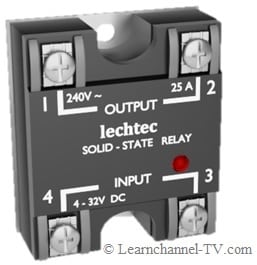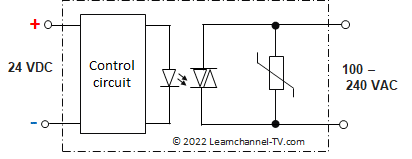Home ⇒ Overview Courses ⇒ Electronics ⇒ Electronic Load Relay ELR
With the use of conventional relays and contactors, one automatically accepts the disadvantages of mechanical switching, such as contact chatter, corrosion, welding of the switching contacts and a limited service life. But there is an alternative, namely electronic switching by using so-called solid-state relays.
Electronic Load Relay ELR or Solid-State Relay SSR - How it works
Common names: Electronic Load Relay ELR, Solid-State Relay SSR or Semiconductor relay.

Solid-State Relay or Electronic Load Relay
As already indicated, the electronic load relay has no moving parts. If you want to understand the structure and operation, you should know:
- An optocoupler is used to fulfill the condition of galvanic isolation between control and load circuit as well as potential-free switching.
- To be able to switch a high power on the output side, an electronic actuator is required. This can be a transistor, if a DC voltage is to be switched, or a TRIAC, which is also designed for AC voltage as well as for higher power.
- Often, these electronic load relays are already equipped with overvoltage protection and protection against negative voltage peaks, which occur when switching off inductive loads.
Below is a simplified circuit of a semiconductor relay:

Electronic Load Relay ELR, Solid-State Relay SSR - structure and function (simplified)
The following comparison of the advantages and disadvantages of a solid-state relay versus an electromagnetic relay is intended to help you make your decision (without claiming to be complete):
| Electromagnetic Relay | Solid State Relay |
|---|---|
| + high switching capacity + high insulation resistance + high blocking voltage | + fast switching times + high switching frequencies + long service life + noiseless switching + safe operation in case of vibrations and shocks - Voltage drop from approx. 0.4V up to approx. 1.4V |
... coming soon - we are working on it

